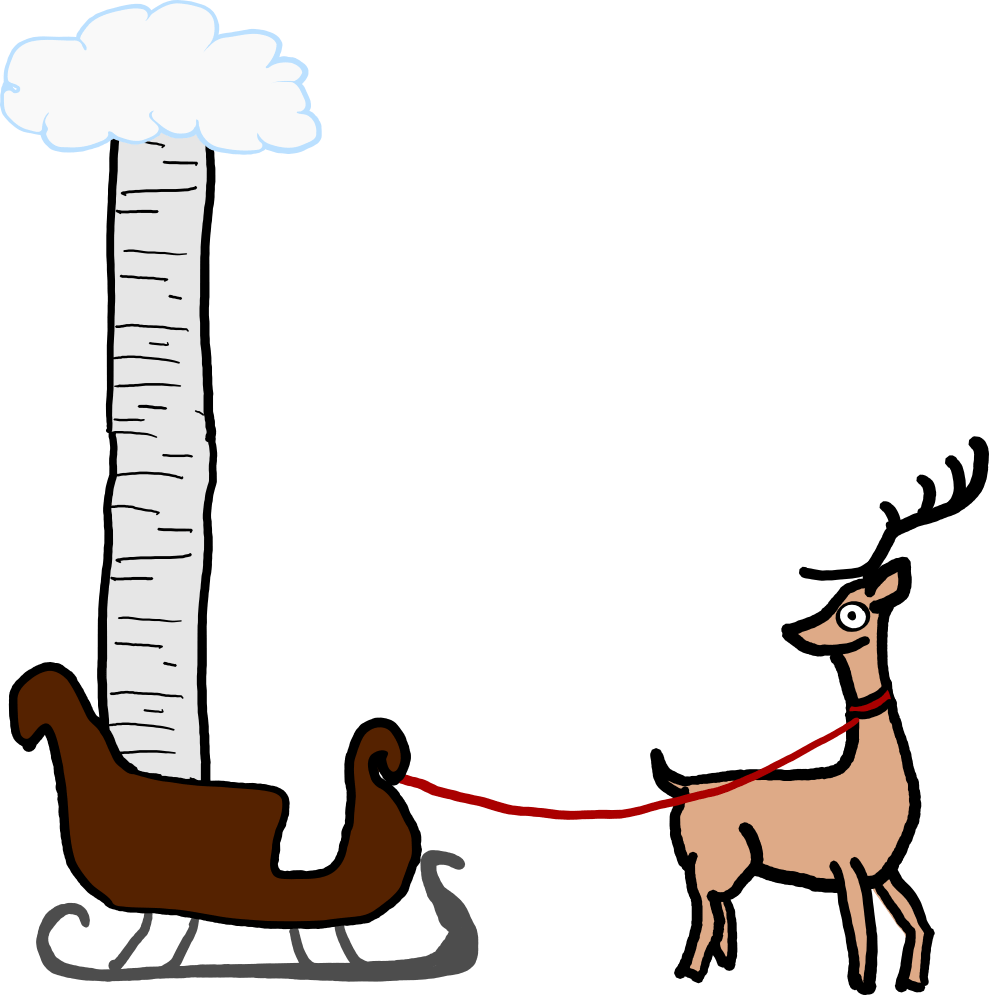Santa’s gift tour is a headache for children every year: How does he manage to visit every child in the world in a single night? But Santa’s travel speed is not the only problem. I wonder: how does he know if the child whose chimney, balcony, or front door he is standing in front of has been naughty or nice? Does he carry around the Naughty and Nice List in paper form? Is he in radio contact with the North Pole? Or does he have a completely different method?
Reliable as he is, he made the Naughty and Nice List in time and checked it twice. Last year, I told Santa a trick to make this test even faster and more effective by putting a child in a room with a present and using the power of quantum entanglement. Since he is making a list in the first place, I assume that he has not stored the names and naughty-status of all the children in the world in his head by means of breathtaking mnemonics. So the first question would be: How long is the Naughty and Nice List and does it even fit into Santa’s sleigh?
13 elephants from the North Pole to South Africa
Let’s do some quick maths. Right now, there are 7.78 billion people in the world, 18.9% of whom are children between the ages of 0 and 10 [1], who receive presents from Santa. If he writes each name neatly one below the other with a line-height of about 1 cm – which is rather dense – the list is 14700 km long. If rolled out, it would reach from the North Pole to South Africa.
If his scroll is 14 cm wide, as much as an A5 sheet, and even if he writes on both sides to save space, this chunk of paper weighs 80 tons – as much as 13 elephants. If Santa wrote his list neatly in an A5-sized book, it would be 3.5 km thick. Even if Rudolph and his friends were on steroids, I doubt they could pull this sleigh (don’t get me started on the weight of the presents).
Three years of telephone duty
So taking the old-school paper list with him is not an option. Instead, Santa thinks he could just take a phone and call the head elf who sits at the North Pole with the Naughty and Nice List and tells him whether each child has been good or bad. Assuming the children were evenly distributed between the northern and southern hemispheres, Santa’s average distance from the North Pole would be a good 10 thousand kilometres (the distance from the North Pole to the equator).
Santa and his elves are professionals; they don’t have to search long in the list, it’s a snap. So the time for transmission is only limited by the speed of light. The signal has to travel once from Santa to the North Pole (“Tiny Tim?”) and back (“Nice!”). That takes just 66 milliseconds per child. Sounds great! But with 1.47 billion children, the procedure takes a whole 3.1 years! Just to find out whether the children were well-behaved, and that with communication at the speed of light!
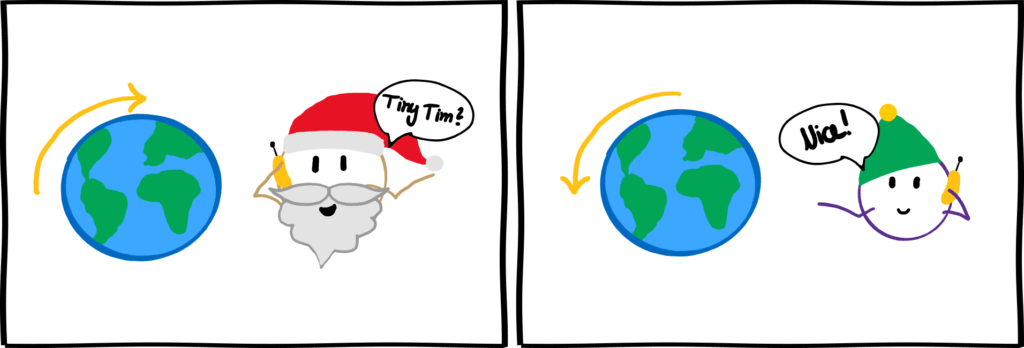
No doubt: that’s far too long. Einstein once said that the speed of light is the absolute upper limit for information transfer: you can’t go any faster. Is that really true? Or isn’t there a method of transmitting signals faster than the speed of light – also known as superluminal?
Idea 1: Entanglement
Santa, who likes to browse through quantum physics books by the fireplace with milk and biscuits in his spare time, has an idea. He has just read about entanglement, which Einstein called “spooky action at a distance”. Supposedly, it allows one particle to be instantly influenced by another at any distance. Couldn’t he use this for his superluminal elf radio?
He imagines the whole thing like this: Santa and his elf prepare for Day X by entangling two photons (you can read details about entanglement in my post on quantum computing, the short version is here again now). This means that the state of one photon depends on the state of the other photon. For example, they prepare them in such a way that either both photons are always “pointing up” or both are “pointing down” – like two coupled switches.
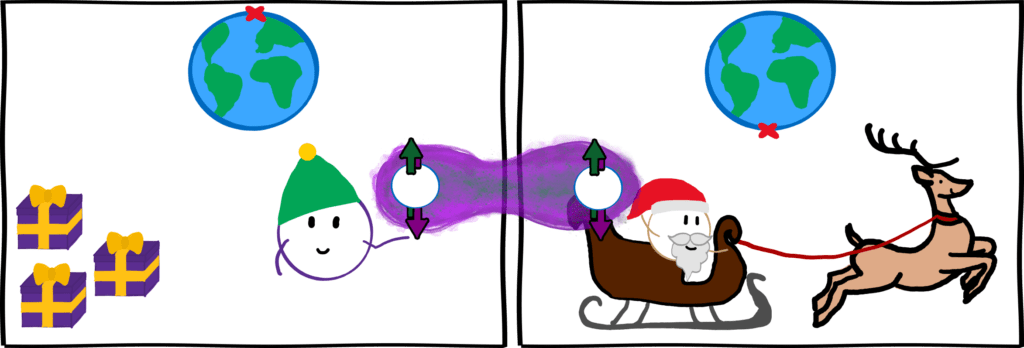
Santa then takes one of the two photons with him in the sledge and flies to the South Pole (since light weighs nothing, Rudolph is also happy about the light weight); the elf keeps the other one at the North Pole. There he now measures the state of his photon: with 50% probability it points upwards, with 50% it points downwards. For example, he gets the result: up, and that stands in the Christmas code for: nice.
Now the elf knows with absolute certainty that Santa’s photon is also in the state “up” – and not 66 ms later, but at the exact same moment without any delay. It was precisely this phenomenon, that the elf’s measurement of his photon immediately influences Santa’s photon at the South Pole, that Einstein called “spooky action at a distance”. That couldn’t be, he said, it was nonsense. Nothing could be faster than light.
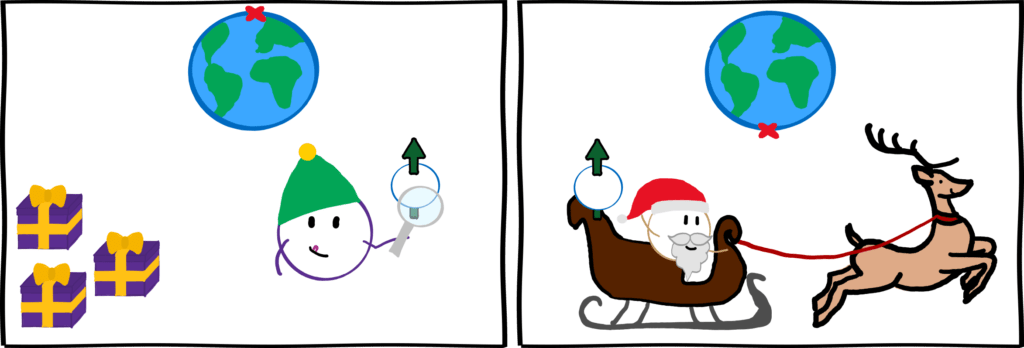
This sounds great to Santa: can’t he use it to make the superluminal elf radio? All he has to do is take a photon for each child, the elf measures one at a time and influences Santa’s photons accordingly without any delay.
I’ll make it quick: it doesn’t work. For two reasons: First, the elf’s measurement result is completely random. He cannot influence whether the photon answers with naughty or nice. Secondly, although the elf knows what Santa’s photon is doing after the measurement, Santa has no idea what is going on. If he gets the result nice after a measurement, he can’t tell whether that’s because his elf measured his photon first and got it nice, or whether he measured it first and got the result nice by chance (i.e. with 50% probability).
In other words, the whole thing is a perfectly correlated dice roll. The outcome of both dice is always the same, but dice cannot transfer information.
This principle, that no information can be transmitted with entanglement, also has a name in quantum physics: The no-communication theorem. It can also be shown mathematically. Einstein is happy once more because he does not say that nothing can be faster than light, he merely says that information cannot be transmitted faster than the speed of light. And entanglement can’t do that either.
Idea 2: The tunnel effect
But Santa is not giving up yet. He likes to listen to music in his sleigh to pass the time. As a true Northman, he naturally likes to listen to Viking Metal (the men there are just as big and bearded as he is, he likes that), but every now and then he also likes to listen to Mozart. Symphony No. 40 is playing when he remembers something: a few years ago, it was reported in the news that this very piece was transmitted at the speed of faster than light; 4.7 times the speed of light to be precise [2]. That sounds promising!
This experiment is based on the tunnel effect, another quantum mechanical effect. In short, it says that quanta can pass through walls like ghosts. If a barrier blocks a particle’s path, it can still flit through with a certain probability; it digs itself a “tunnel”, so to speak.
At the time, the researchers believed they had observed that a photon hurtling towards a barrier would emerge on the other side almost instantly – moving through the wall faster than the speed of light! To emphasise this point, they encoded Mozart’s symphony and sent it through the wall, supposedly at 4.7 times the speed of light. Even Mozart couldn’t play it that fast!
This experiment has sparked heated debates among scientists [3,4]. The experimenters had not understood quantum physics and had interpreted the concept of speed to their advantage, they said. Many technical details, but the moral of the story: even Mozart can’t go faster than light.
Idea 3: Tachyons
Santa has a guilty pleasure: he likes to flip through esoteric catalogues and came across a DIY tachyon accelerator. Tachyons are particles that travel at the speed of faster than light. If a tachyon were to fly past you, you would only be able to see it after it had already passed. Similar to a supersonic jet that you don’t hear until it’s already gone. It then follows from special relativity that tachyons would move backwards in time. With the help of tachyons, one could therefore build an “anti-telephone” that could send messages into the past [5].
But alas, what the eso catalogue doesn’t mention: tachyons are hypothetical particles. Theoreticians like to ask the question “What if?”. What if there were particles that were faster than light? Exciting question; just like the question of how Santa Clause communicates with his elves. Because of the causality problems that would arise from an anti-telephone (What if I called my past self to tell me not to call myself?), physicists do not believe that tachyons can exist.
Idea 4: Wormholes
Santa has a lot of free time all year round and enjoys watching Netflix with his reindeers while the elves build the toys. He particularly enjoyed the film Interstellar and when he saw a spaceship (which is also just a big sled, he thinks) dive through a wormhole, he got another idea.
Wormholes are sort of shortcuts through space that follow from Einstein’s general theory of relativity. Couldn’t Santa simply integrate a wormhole into his gift bag, the other end of which terminates at the North Pole? That would solve two problems at once: the superluminal elf radio and the gift transport! Rudolph will be happy!
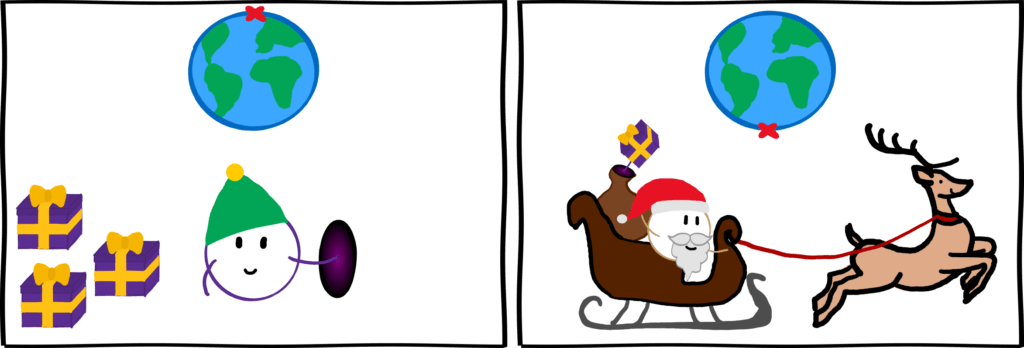
From a physical point of view, there is actually surprisingly little to be said against this idea. Causality would be maintained and the speed of light would not be exceeded.
The only problem is that no wormholes have yet been found or created. So far, they are purely theoretical considerations, but they have not yet been ruled out. Researchers recently discovered, for example, that long, skinny wormholes that only allow light (i.e. information) to pass through should be theoretically possible [6].
The practical implementation is still a problem, but those who own flying reindeer will find a solution for this too.
Do you like what you read? Then you can buy me a coffee here! And if you don’t want to miss any new posts, don’t forget to subscribe to my blog.
References
[1] Statistica, Anteil der Kinder und Jugendlichen (0- bis 17-Jährige) an der Weltbevölkerung nach Altersgruppen im Jahr 2020
[2] On causality proofs of superluminal barrier traversal of frequency band limited wave packets, W.Heitmann & G.Nimtz, https://doi.org/10.1016/0375-9601(94)91218-1
[3] Superluminales Tunneln, Ernst-Udo Wallenborn, 1994
[4] Wissenschaft.de, Stürzt Einsteins Dogma?
[5] The Tachyonic Antitelephone, https://journals.aps.org/prd/abstract/10.1103/PhysRevD.2.263
[6] New Scientist, Skinny wormholes could send messages through time

